![]()

|
KEY: |
|||||||||||
|
|
|
||||||||||
|
|
Refers to the exhibit graphics and the instructions in them |
||||||||||
|
|
Refers to things to do not suggested in the instructions on the exhibit |
||||||||||
Ever wonder about voices? We can express so much with the sounds we make- everything from applause to screams, burps, laughter, and long complicated explanations. So where do these sounds come from, and how do we distinguish them? This pathway takes you to some exhibits where you can explore the complex sounds you make.
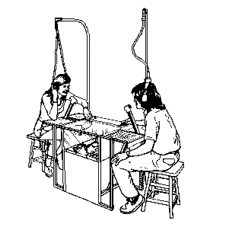
![]()
This exhibit messes with the "feedback loops" that we unconsciously use while speaking: We listen to ourselves constantly and adjust our speech according to the way we sound.
![]()
Try different levels of delay.
- Around what delay setting does it become most difficult to speak- at a lot of delay? A little? Somewhere in between?
![]()
Though your voice contains many different pitches, or frequencies of sound, what is usually heard when you speak is a combination of these. This exhibit lets you change your average pitch.
![]()
- When you do this exhibit with a friend, can you tell the difference between your two voices at the same high or low frequency?
![]()
Try to speak in a low voice then increase the pitch to make it sound normal. Then try the opposite, speaking in a high voice.
- What happens when you try to do this?
![]()
This is a drawing showing the motion of the vocal cords:
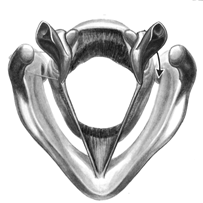
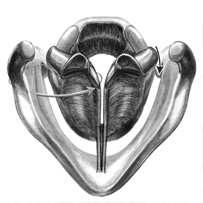
What we call vocal cords are actually more like flaps. Their shape and spacing is responsible for most of the speech sounds we make, affecting the patterns of vibration in our voice box or larynx.
- Have you noticed your own voice change over the years? How?
- Do taller people seem to have different voices than shorter people? If so, why do you think this might be?
- How is your voice unique/different from your classmates?
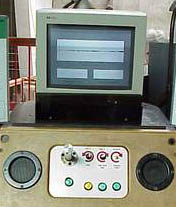
![]()
What is it like to hear the sound of your own voice? A lot of people think they sound weird. One reason for this is that you "hear" your own voice (while you are speaking) through the bones in your skull that surround your inner ear- the vibrations haven't gone through the air like they do when other people hear them (or when they‚re recorded through a microphone)! This exhibit lets you see your own speech, and do some pretty strange things with it.
![]()
Check out the graph of the sounds you make.
1. Why is the graph shaped that way?
![]()
Record your name (making sure you say it while the red line is moving across the screen). Now play it backwards until you think you can say your name backwards. When you can do this, record yourself saying your name backwards! Now, play THAT word backward!
- Does it sound like your name?
- In your group, whose name was easiest to say backwards?
- Why?
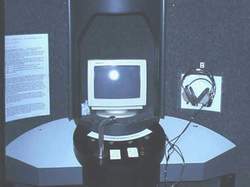
![]()
Ever wonder exactly how well you could hold a note? Is there a singing career in your future after all? This exhibit might let you know. (But don‚t forget the importance of practice!)
![]()
Compete with your friends to see who can hold a steady note the longest.
- Who is the undisputed winner?
![]()
Try raising and lowering the notes you sing along with.
- What
is your voice class? (Bass? Baritone? Soprano?)
- Choose
the option "Game."
Can you keep your pitch between the lines (without going "out") for a whole screen-length?
![]()
Our voices contain many different frequencies of vibration. If we try, we can make a single frequency stand out. At this exhibit you can measure the frequencies (high or low) and decibel levels (loudness) of your voice.
![]()
- Which frequencies are most prominent in your own voice?
- How "pure" of a tone can you sing? Can you make a single frequency stand out? Which one seems easiest or most natural for you?
![]()
- Ask a friend of a different sex to try it. Notice anything different?
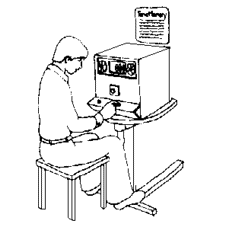
![]()
This exhibit helps you find out how good of an "ear" you have.
![]()
- How close can you get to the constant tone? Write down your first three guesses.
- If you play both tones together, what happens when you get the adjustable tone close to, but not right on, the constant tone?
![]()
Does everyone have the same hearing range? How does our hearing range compare to that of other animals?
![]()
Test the limits of your hearing with a few friends.
- Who has the best range? Write down your own range and the best one.
- From looking at the chart, how does the human hearing range compare to the sound range of our speech?
- What is the highest frequency sound you have heard? The lowest?
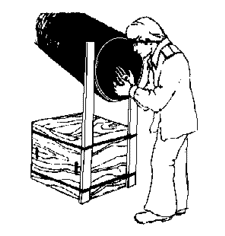
![]()
Just like a ball thrown at a wall, the vibrating air produced when you shout in the Echo Tube bounces off of the sides of the tube and finds it way back to your ears.
![]()
- What happens when you clap in the tube? A clap is a bunch of different sound waves heard together- but each of the individual waves (some short- the high frequency ones, and some long- the low frequency ones) reflects differently in the tube.
- Which sounds do you think echo the quickest- the high ones or the low ones?
- Can you remember a place where you heard a great echo? What do you think caused it?
